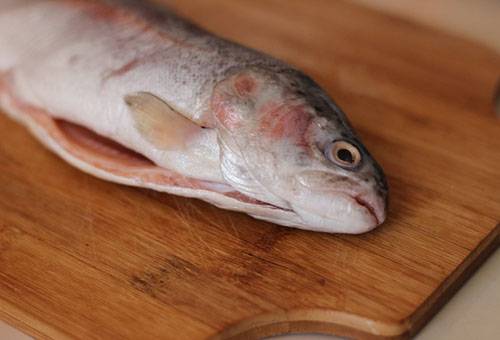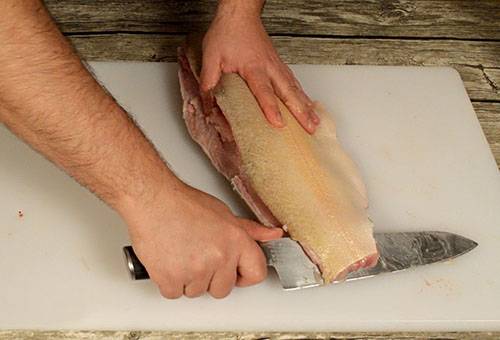Simple rules for cleaning trout and the nuances of cutting it
We are so accustomed to fish that is cleaned and cut for us that, when taking our first steps in cooking, we often avoid buying anything that requires additional effort and manipulation. Anything that is not marked with the word “fillet” is perceived as a product with which there will be no problems: how to clean fish from scales such as trout, sea bass or dorado, gutted and deboned? Not a fish, just some kind of chef's nightmare. But while all of these nuances may be true of some river fish, cleaning trout is so easy that it will keep you coming back to cook this fish again and again.
Have you already decided what you want to cook with trout? Then, when it comes to cleaning, you can navigate the key dishes, because for different recipes the number of preparatory steps may vary.

Roasting a whole carcass
If the fish is small and you want to bake or fry it whole, then we assure you that you can clean it in just 5 minutes. The thing is that trout scales are not like the scales of carp or perch and are very small plates that can be cleaned off the fish without much physical effort.
- So, first you need to rinse the fish in running water. If the trout is very slimy and such a carcass is uncomfortable to hold in your hands, then even repeated washing is unlikely to help you. It's better to just sprinkle salt on the fish to create friction: you'll still have to salt it later anyway.
- It is best to clean trout directly in the sink: due to the fact that the scales do not adhere firmly to the skin, they practically do not scatter around the kitchen, but if something gets on the cabinets, table or floor, then perhaps you simply will not notice the contamination. The walls of the sink will save you from such a nuisance, and collection at the drain will allow you to collect all the large scales and prevent the water supply from clogging.
- It is convenient to clean trout with a small knife both against and in the direction of the scales. You need to be especially careful in the abdomen area: the skin color there is lighter and the scales are noticeably worse, but at the same time they are tougher there than on the sides. Run your finger along the belly from head to tail to make sure the meal isn't ruined by crunching on your teeth.
- If the fish is not gutted, it is not so difficult to do it yourself: cut the abdomen from the anal fin to the gills and take out all the insides. If you find caviar, you can salt it, but feel free to throw everything else in the trash.
- There is no need to cut off the head: it is enough to remove the gills so that the dish does not acquire the wrong taste. In addition, the gills, like a filter, collect not the most useful substances, so it is advisable to remove them if you care about your health.
- Rinse the fish again, and that’s it – you’re ready to bake!
Advice
You don’t have to touch the fins and tail: it’s not for nothing that in many cafes they are left with the fish for the beauty of presentation.
If you do clean fish on a board, then let it be a board for meat or a separate board for fish. Are you going to grab a board for vegetables and bread? We advise you to think about the risk of parasite infection and at least lay down a newspaper.
Fillet, sushi, salad cuts
When planning to prepare a dish that requires pieces of trout or its fillet, be prepared to add a few points to the cutting process. How to clean trout so that it can be added to salad or sushi? You can see all the basic actions above, but here are the manipulations that we will do now.
To get appetizing pieces, we need to remove the skin from the trout. You can remove it from a small fish with a stocking after cutting off the head, but for small fish this action rarely makes sense: it is very difficult to get a sufficiently thick layer of fillet from it, so this option is not used often.
- If the fish is large, then before skinning it, you will have to cut the carcass. To do this, after first cutting off the head, you will need to cut the fish along the back line along the spinal bone. As a result, you will get 2 identical halves, one of which will have a ridge.
- The spine and bones will need to be removed, but it is not necessary to throw it away. Most likely, there will be some meat left on it, and the base of the backbone of a fairly large trout can be used to make soup. The fins are also cut out at this stage.
- Well, the last step is to cut the fillet from the skin. If you've ever made sandwiches with red fish, you can imagine this process: after trimming the fillet, you need to cut off the meat, pressing the knife against the board so that there are no large pieces left on the skin. The only thing is that working with raw trout and removing the fillet in one piece will require a little skill. The key to success will also be a fairly strong and long knife: it is advisable that the length of the knife be no shorter than the width of the fillet.
Advice
Start prying the fillet from the tail: since the length of the fillet is shorter there, it is more convenient to start cutting the meat in this direction.
Cleaning both small and large trout is easy if you put this dressing guide into practice. We are confident that in the future, when planning to prepare a dish from its tender meat, you will not delay the culinary experiment due to your reluctance to deal with cleaning the fish.
We recommend reading: how to clean perches
